Single-Cell RNA-Sequencing Reveals Epithelial Cell Signature of Multiple Subtypes in Chemically Induced Acute Lung Injury
Abstract
:1. Introduction
2. Results
2.1. Cell Sequencing and Clustering to Identify Main Cell Types
2.2. SOX9-Positive AEC2 Differentiation and Maturation Trajectories
2.3. Annotation of Pulmonary Epithelial Subtype Based on the Marker Gene
2.4. Proliferation of SOX9-Positive AEC2s in the Bronchoalveolar Area in CALI Rats
2.5. scRNA-seq Uncovers DEGs Predominantly Expressed in AECs during CALI
3. Discussion
4. Materials and Methods
4.1. Animals and Grouping
4.2. Isolation and Preparation of Single Cells and Collection of Lung Tissues
4.3. scRNA-seq
4.4. Data Quality Control
4.5. Integrated Analysis
4.6. Unsupervised Clustering and Annotation
4.7. GO Term and KEGG Pathway Enrichment Analysis
4.8. Identification of DEGs
4.9. Developmental Trajectory Inference
4.10. Reverse Transcription-Quantitative Polymerase Chain Reaction
4.11. Immunohistochemical Staining and Immunohistochemical Score
4.12. Immunofluorescence
4.13. Western Blot Analysis
4.14. Statistical Analysis
5. Conclusions
Supplementary Materials
Author Contributions
Funding
Institutional Review Board Statement
Informed Consent Statement
Data Availability Statement
Acknowledgments
Conflicts of Interest
References
- Dries, D.J.; Endorf, F.W. Inhalation injury: Epidemiology, pathology, treatment strategies. Scand. J. Trauma Resusc. Emerg. Med. 2013, 21, 31. [Google Scholar] [CrossRef] [PubMed] [Green Version]
- Radbel, J.; Laskin, D.L.; Laskin, J.D.; Kipen, H.M. Disease-modifying treatment of chemical threat agent-induced acute lung injury. Ann. N. Y. Acad. Sci. 2020, 1480, 14–29. [Google Scholar] [CrossRef] [PubMed]
- Cao, C.; Zhang, L.; Shen, J. Phosgene-Induced acute lung injury: Approaches for mechanism-based treatment strategies. Front. Immunol. 2022, 13, 917395. [Google Scholar] [CrossRef] [PubMed]
- Sciuto, A.M. Assessment of early acute lung injury in rodents exposed to phosgene. Arch. Toxicol. 1998, 72, 283–288. [Google Scholar] [CrossRef] [PubMed]
- Pusateri, A.E.; Homer, M.J.; Rasmussen, T.E.; Kupferer, K.R.; Hoots, W.K. The interagency strategic plan for research and development of blood products and related technologies for trauma care and emergency preparedness 2015–2020. Am. J. Disaster Med. 2018, 13, 181–194. [Google Scholar] [CrossRef]
- Holmes, W.W.; Keyser, B.M.; Paradiso, D.C.; Ray, R.; Andres, D.K.; Benton, B.J.; Rothwell, C.C.; Hoard-Fruchey, H.M.; Dillman, J.F.; Sciuto, A.M.; et al. Conceptual approaches for treatment of phosgene inhalation-induced lung injury. Toxicol. Lett. 2016, 244, 8–20. [Google Scholar] [CrossRef] [Green Version]
- Aggarwal, S.; Jilling, T.; Doran, S.; Ahmad, I.; Eagen, J.E.; Gu, S.; Gillespie, M.; Albert, C.J.; Ford, D.; Oh, J.Y.; et al. Phosgene inhalation causes hemolysis and acute lung injury. Toxicol. Lett. 2019, 312, 204–213. [Google Scholar] [CrossRef]
- Lu, Q.; Huang, S.; Meng, X.; Zhang, J.; Yu, S.; Li, J.; Shi, M.; Fan, H.; Zhao, Y. Mechanism of Phosgene-Induced Acute Lung Injury and Treatment Strategy. Int. J. Mol. Sci. 2021, 22, 10933. [Google Scholar] [CrossRef]
- Kawami, M.; Takenaka, S.; Kadekaru, Y.; Akai, M.; Konaka, T.; Yumoto, R.; Takano, M. Evaluation on epithelial-mesenchymal state and microRNAs focusing on isolated alveolar epithelial cells from bleomycin injured rat lung. Toxicology 2021, 461, 152903. [Google Scholar] [CrossRef]
- Olivera, D.S.; Hoard-Fruchey, H.; Sciuto, A.M. Evaluation of an in vitro screening model to assess phosgene inhalation injury. Toxicol. Mech. Methods 2017, 27, 45–51. [Google Scholar] [CrossRef]
- McQualter, J.L.; Yuen, K.; Williams, B.; Bertoncello, I. Evidence of an epithelial stem/progenitor cell hierarchy in the adult mouse lung. Proc. Natl Acad. Sci. USA 2010, 107, 1414–1419. [Google Scholar] [CrossRef] [Green Version]
- Zuo, W.; Zhang, T.; Wu, D.Z.; Guan, S.P.; Liew, A.A.; Yamamoto, Y.; Wang, X.; Lim, S.J.; Vincent, M.; Lessard, M.; et al. p63+ Krt5+ distal airway stem cells are essential for lung regeneration. Nature 2015, 517, 616–620. [Google Scholar] [CrossRef]
- Vaughan, A.E.; Brumwell, A.N.; Xi, Y.; Gotts, J.E.; Brownfield, D.G.; Treutlein, B.; Tan, K.; Tan, V.; Liu, F.C.; Looney, M.R.; et al. Lineage-negative progenitors mobilize to regenerate lung epithelium after major injury. Nature 2015, 517, 621–625. [Google Scholar] [CrossRef] [Green Version]
- Rodríguez-Castillo, J.A.; Pérez, D.B.; Ntokou, A.; Seeger, W.; Morty, R.E.; Ahlbrecht, K. Understanding alveolarization to induce lung regeneration. Respir. Res. 2018, 19, 148. [Google Scholar] [CrossRef] [Green Version]
- Qiu, X.; Mao, Q.; Tang, Y.; Wang, L.; Chawla, R.; Pliner, H.A.; Trapnell, C. Reversed graph embedding resolves complex single-cell trajectories. Nat. Methods 2017, 14, 979–982. [Google Scholar] [CrossRef] [Green Version]
- Rockich, B.E.; Hrycaj, S.M.; Shih, H.P.; Nagy, M.S.; Ferguson, M.A.; Kopp, J.L.; Sander, M.; Wellik, D.M.; Spence, J.R. Sox9 plays multiple roles in the lung epithelium during branching morphogenesis. Proc. Natl Acad. Sci. USA 2013, 110, E4456–E4464. [Google Scholar] [CrossRef] [Green Version]
- Chen, S.; Li, K.; Zhong, X.; Wang, G.; Wang, X.; Cheng, M.; Chen, J.; Chen, Z.; Chen, J.; Zhang, C.; et al. Sox9-expressing cells promote regeneration after radiation-induced lung injury via the PI3K/AKT pathway. Stem Cell Res. Ther. 2021, 12, 381. [Google Scholar] [CrossRef]
- Zacharias, W.J.; Frank, D.B.; Zepp, J.A.; Morley, M.P.; Alkhaleel, F.A.; Kong, J.; Zhou, S.; Cantu, E.; Morrisey, E.E. Regeneration of the lung alveolus by an evolutionarily conserved epithelial progenitor. Nature 2018, 555, 251–255. [Google Scholar] [CrossRef]
- Basil, M.C.; Katzen, J.; Engler, A.E.; Guo, M.; Herriges, M.J.; Kathiriya, J.J.; Windmueller, R.; Ysasi, A.B.; Zacharias, W.J.; Chapman, H.A.; et al. The cellular and physiological basis for lung repair and regeneration: Past, present, and future. Cell Stem Cell 2020, 26, 482–502. [Google Scholar] [CrossRef]
- Rock, J.R.; Onaitis, M.W.; Rawlins, E.L.; Lu, Y.; Clark, C.P.; Xue, Y.; Randell, S.H.; Hogan, B.L. Basal cells as stem cells of the mouse trachea and human airway epithelium. Proc. Natl Acad. Sci. USA 2009, 106, 12771–12775. [Google Scholar] [CrossRef]
- Kim, C.F.; Jackson, E.L.; Woolfenden, A.E.; Lawrence, S.; Babar, I.; Vogel, S.; Crowley, D.; Bronson, R.T.; Jacks, T. Identification of bronchioalveolar stem cells in normal lung and lung cancer. Cell 2005, 121, 823–835. [Google Scholar] [CrossRef] [PubMed] [Green Version]
- Barkauskas, C.E.; Cronce, M.J.; Rackley, C.R.; Bowie, E.J.; Keene, D.R.; Stripp, B.R.; Randell, S.H.; Noble, P.W.; Hogan, B.L. Type 2 alveolar cells are stem cells in adult lung. J. Clin. Investig. 2013, 123, 3025–3036. [Google Scholar] [CrossRef] [PubMed]
- Desai, T.J.; Brownfield, D.G.; Krasnow, M.A. Alveolar progenitor and stem cells in lung development, renewal and cancer. Nature 2014, 507, 190–194. [Google Scholar] [CrossRef] [PubMed] [Green Version]
- Rock, J.R.; Hogan, B.L. Epithelial progenitor cells in lung development, maintenance, repair, and disease. Annu. Rev. Cell Dev. Biol. 2011, 27, 493–512. [Google Scholar] [CrossRef] [PubMed] [Green Version]
- Morrisey, E.E.; Hogan, B.L. Preparing for the first breath: Genetic and cellular mechanisms in lung development. Dev. Cell 2010, 18, 8–23. [Google Scholar] [CrossRef] [Green Version]
- Nichane, M.; Javed, A.; Sivakamasundari, V.; Ganesan, M.; Ang, L.T.; Kraus, P.; Lufkin, T.; Loh, K.M.; Lim, B. Isolation and 3D expansion of multipotent Sox9+ mouse lung progenitors. Nat. Methods 2017, 14, 1205–1212. [Google Scholar] [CrossRef]
- Miller, A.J.; Hill, D.R.; Nagy, M.S.; Aoki, Y.; Dye, B.R.; Chin, A.M.; Huang, S.; Zhu, F.; White, E.S.; Lama, V.; et al. In vitro induction and in vivo engraftment of lung bud tip progenitor cells derived from human pluripotent stem cells. Stem Cell Rep. 2018, 10, 101–119. [Google Scholar] [CrossRef] [Green Version]
- Liu, Q.; Liu, K.; Cui, G.; Huang, X.; Yao, S.; Guo, W.; Qin, Z.; Li, Y.; Yang, R.; Pu, W.; et al. Lung regeneration by multipotent stem cells residing at the bronchioalveolar-duct junction. Nat. Genet. 2019, 51, 728–738. [Google Scholar] [CrossRef]
- He, D.K.; Xu, N.; Shao, Y.R.; Shen, J. NLRP3 gene silencing ameliorates phosgene-induced acute lung injury in rats by inhibiting NLRP3 inflammasome and proinflammatory factors, but not anti-inflammatory factors. J. Toxicol. Sci. 2020, 45, 625–637. [Google Scholar] [CrossRef]
- Chua, R.L.; Lukassen, S.; Trump, S.; Hennig, B.P.; Wendisch, D.; Pott, F.; Debnath, O.; Thürmann, L.; Kurth, F.; Völker, M.T.; et al. COVID-19 severity correlates with airway epithelium-immune cell interactions identified by single-cell analysis. Nat. Biotechnol. 2020, 38, 970–979. [Google Scholar] [CrossRef]
- Huang, Y.; Zheng, Y.; Yin, J.; Lu, T.; Li, M.; Liang, J.; Hu, Z.; Bi, G.; Zhan, C.; Xue, L.; et al. Reconstructing the developmental trajectories of multiple subtypes in pulmonary parenchymal epithelial cells by single-cell RNA-seq. Front. Genet. 2020, 11, 573429. [Google Scholar] [CrossRef]
- Butler, A.; Hoffman, P.; Smibert, P.; Papalexi, E.; Satija, R. Integrating single-cell transcriptomic data across different conditions, technologies, and species. Nat. Biotechnol. 2018, 36, 411–420. [Google Scholar] [CrossRef]
- Sun, Y.; Zhou, B.; Mao, F.; Xu, J.; Miao, H.; Zou, Z.; Phuc Khoa, L.T.; Jang, Y.; Cai, S.; Witkin, M.; et al. HOXA9 reprograms the enhancer landscape to promote leukemogenesis. Cancer Cell 2018, 34, 643–658.e5. [Google Scholar] [CrossRef] [Green Version]
- Gupta, N.; Su, X.; Popov, B.; Lee, J.W.; Serikov, V.; Matthay, M.A. Intrapulmonary delivery of bone marrow-derived mesenchymal stem cells improves survival and attenuates endotoxin-induced acute lung injury in mice. J. Immunol. 2007, 179, 1855–1863. [Google Scholar] [CrossRef]
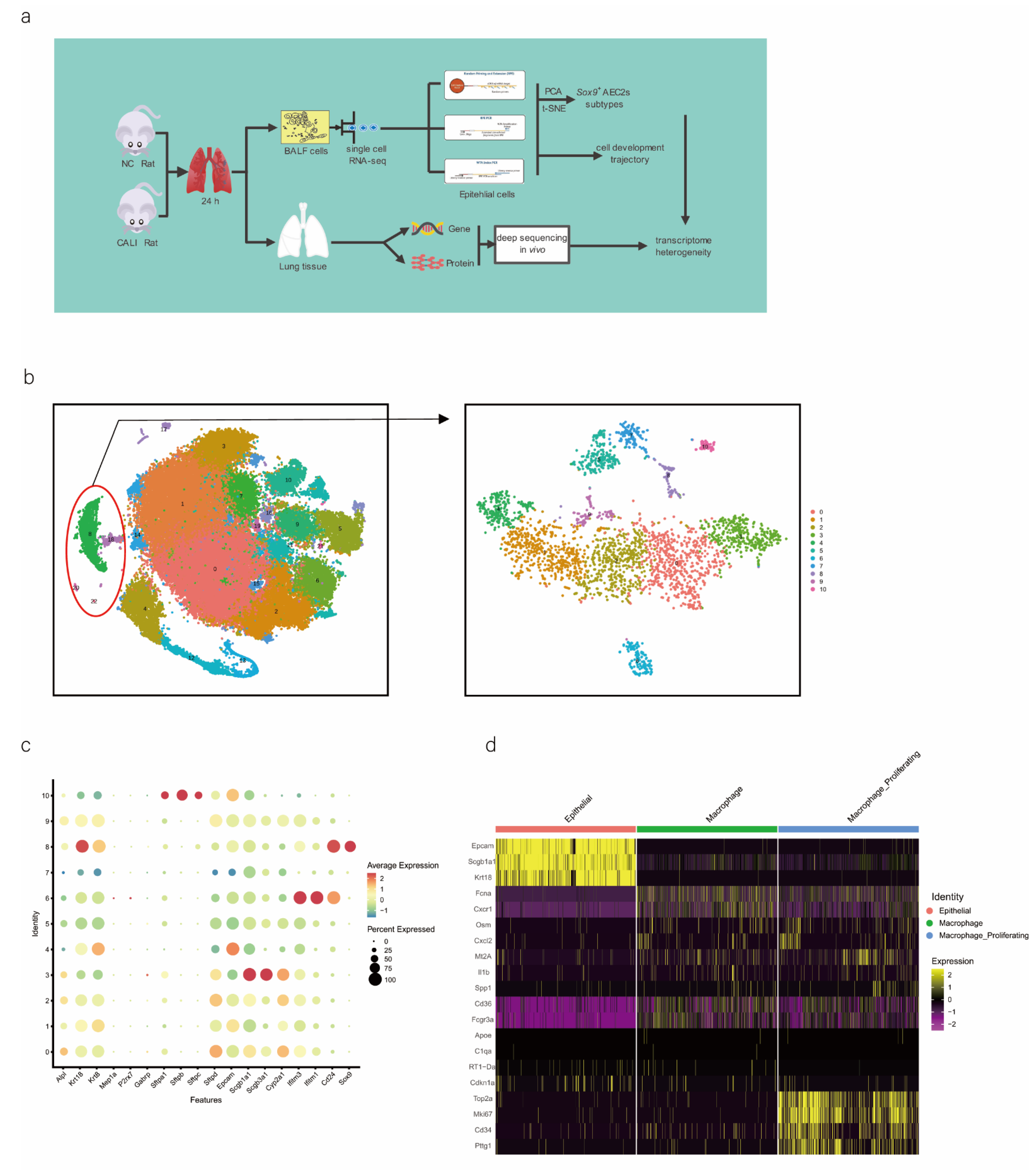
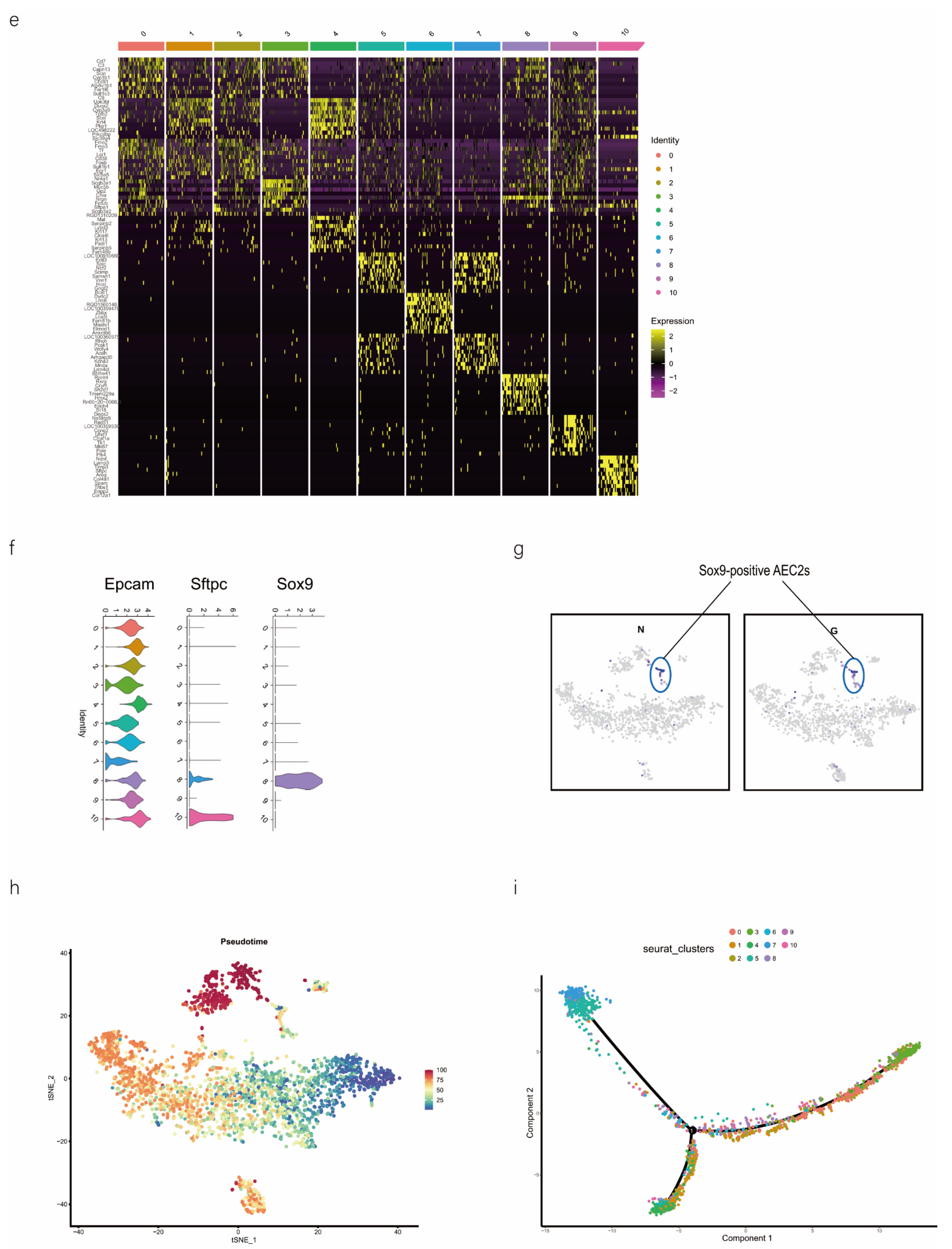
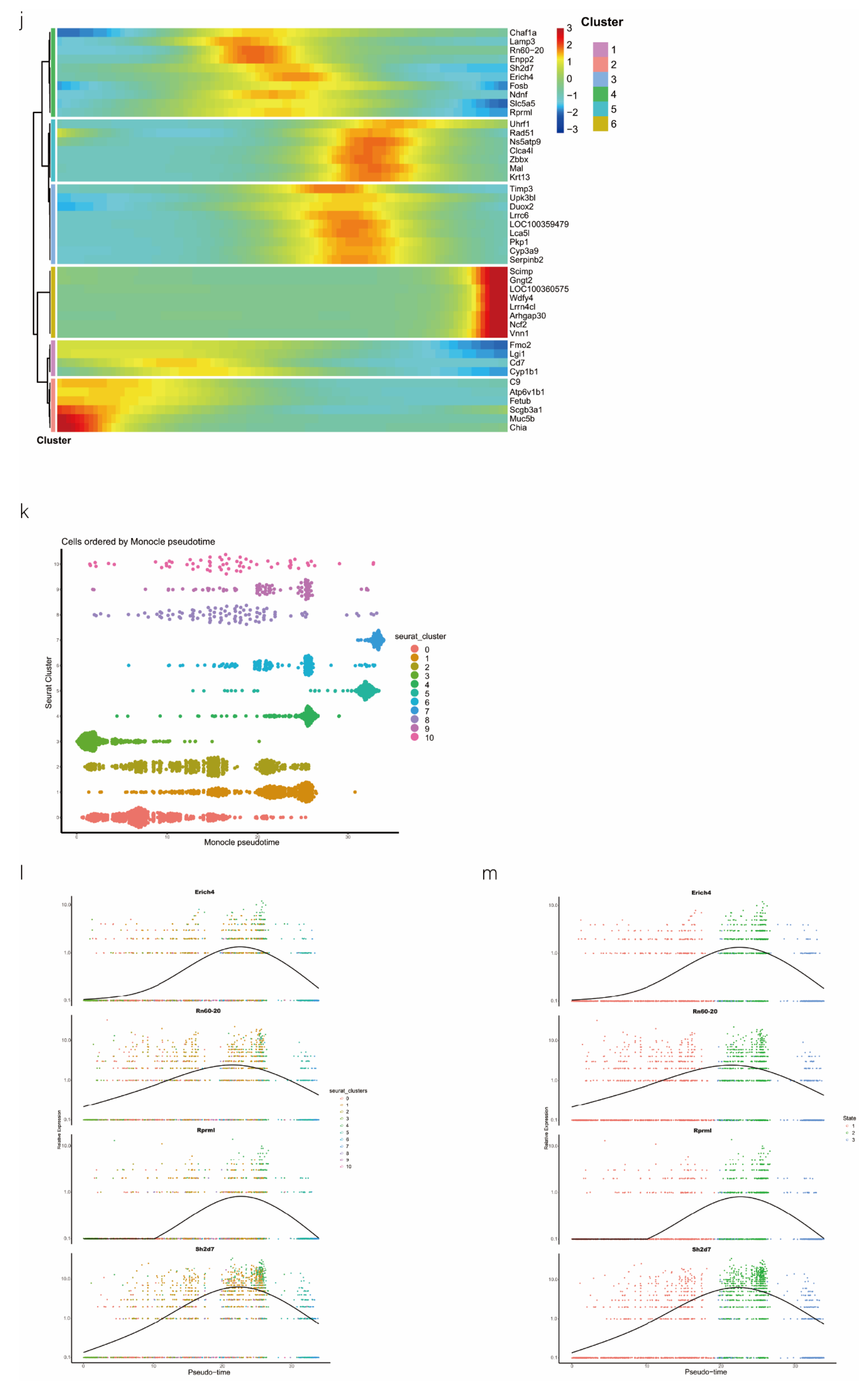
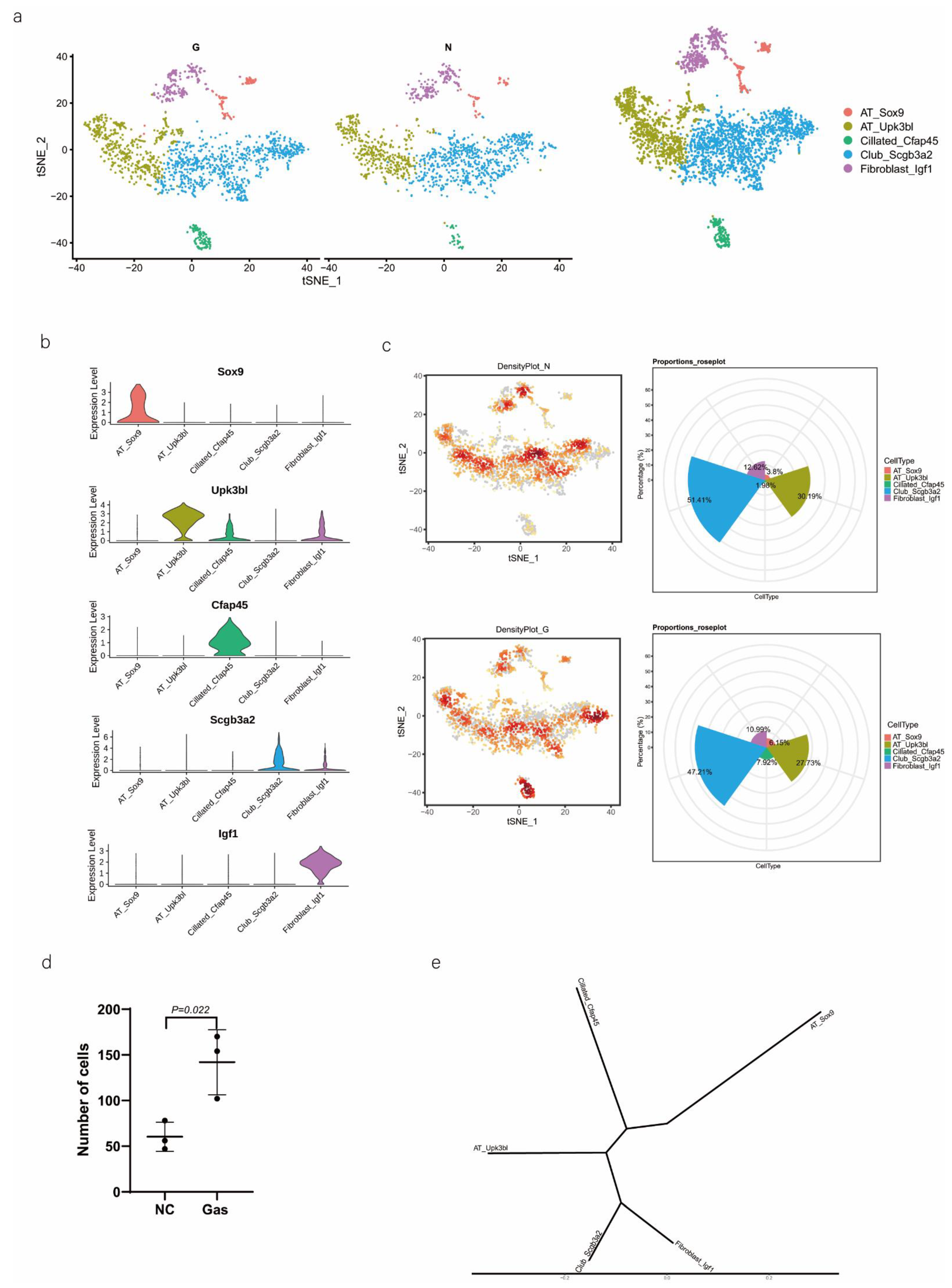
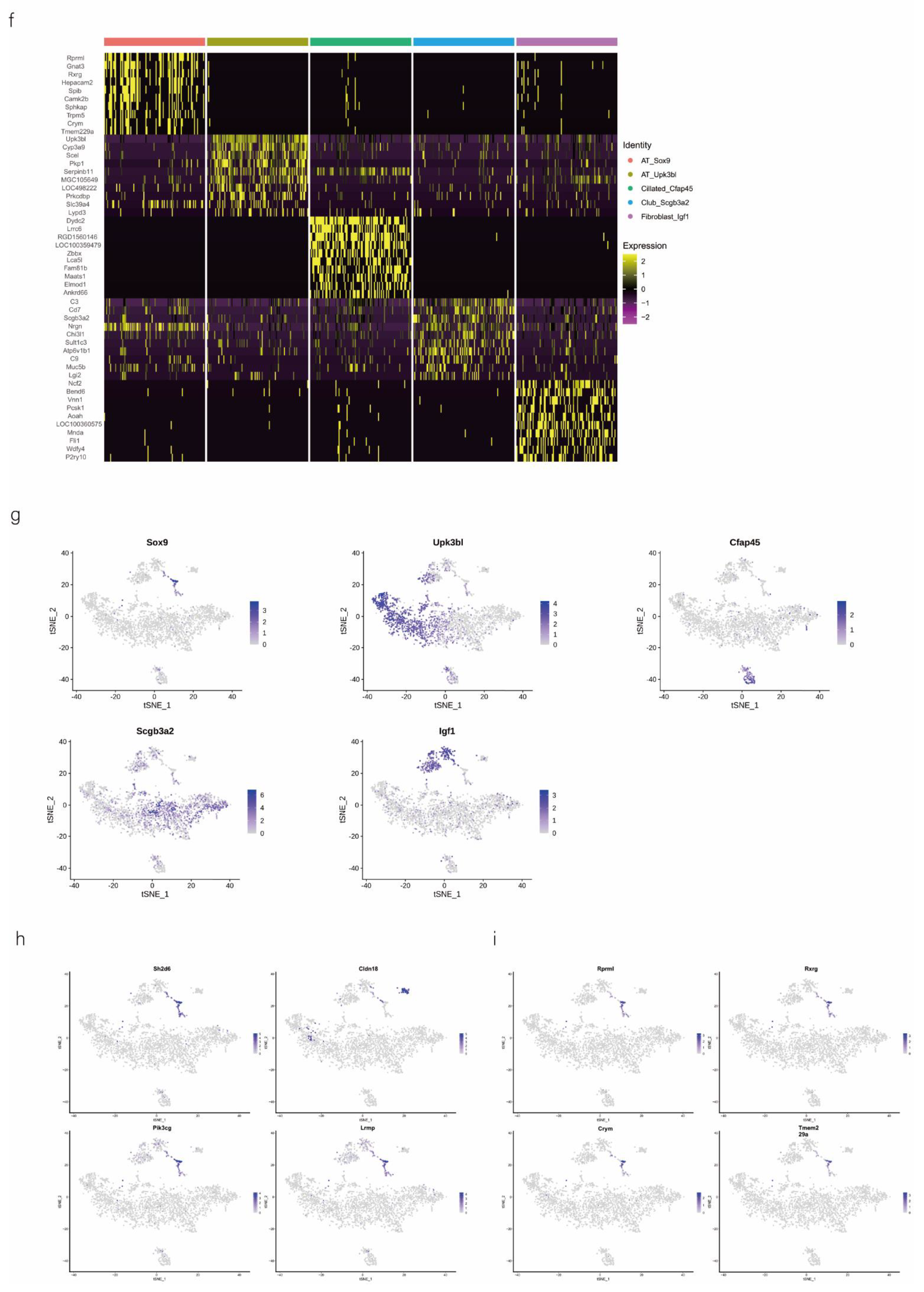
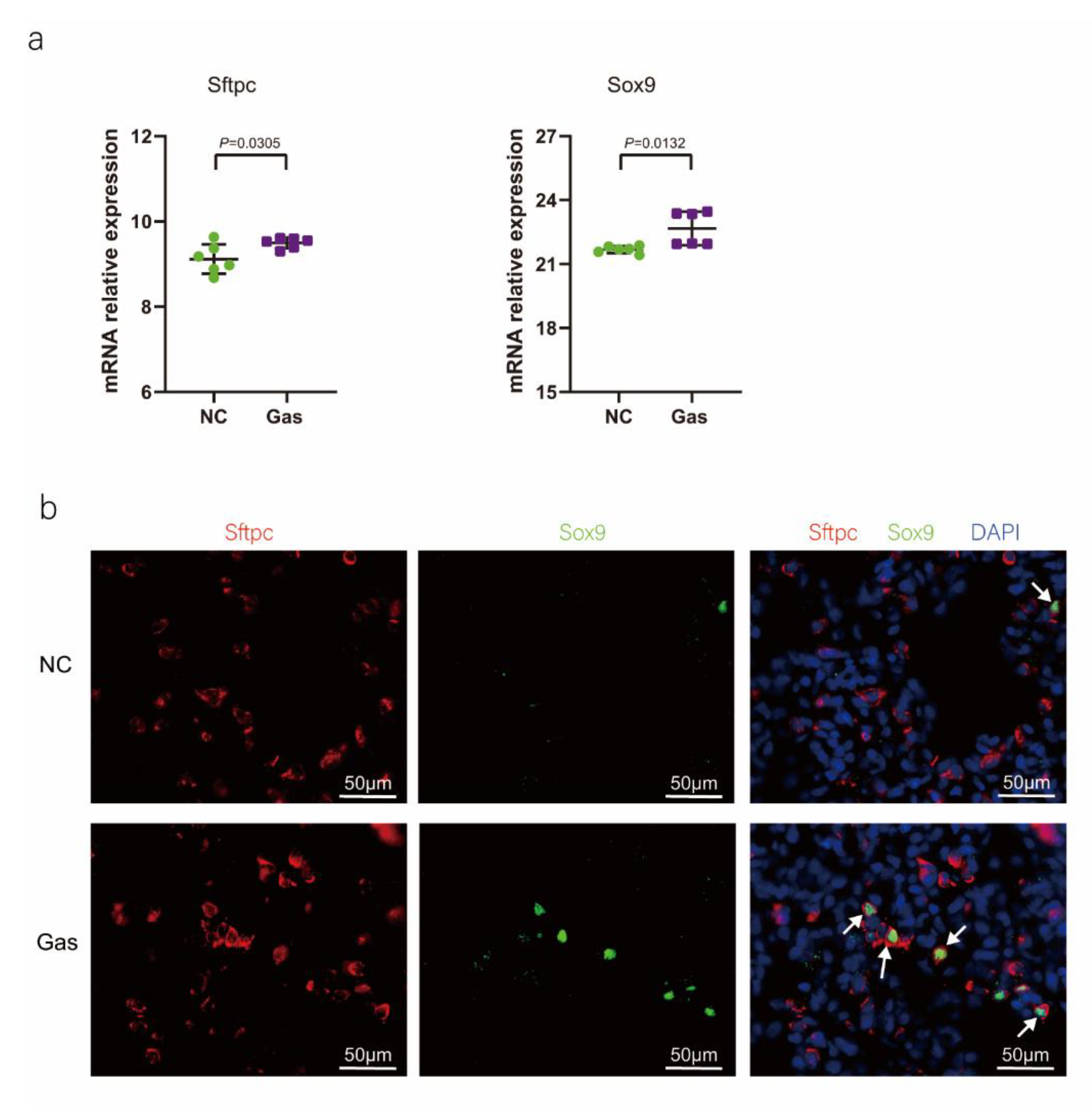
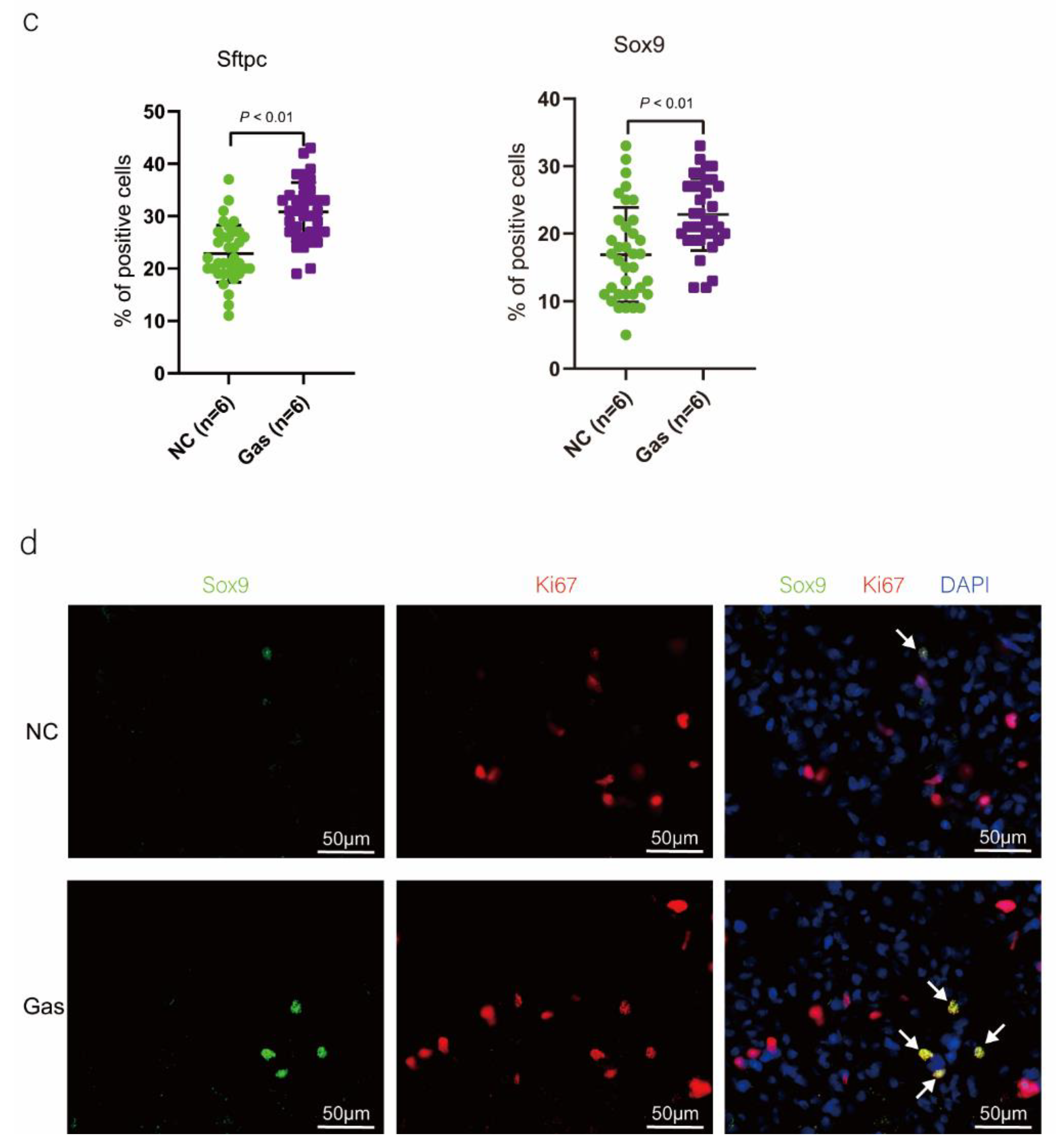

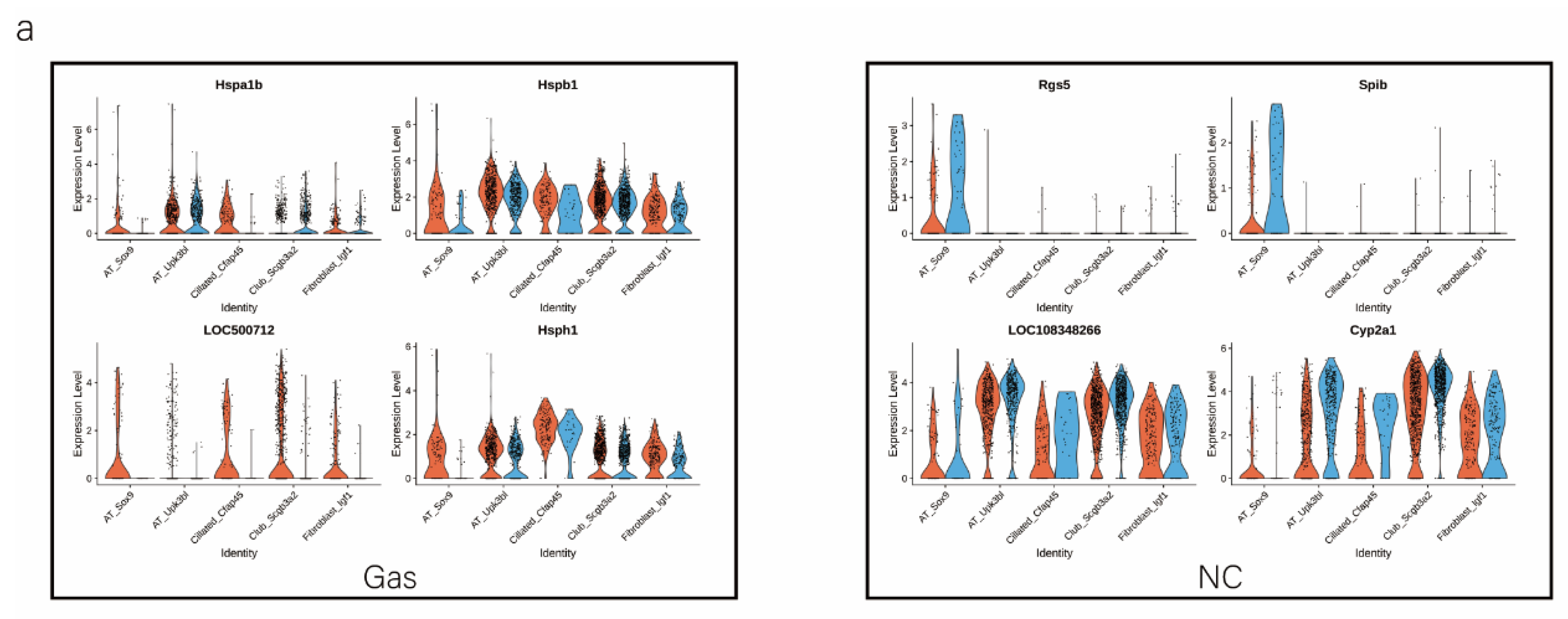
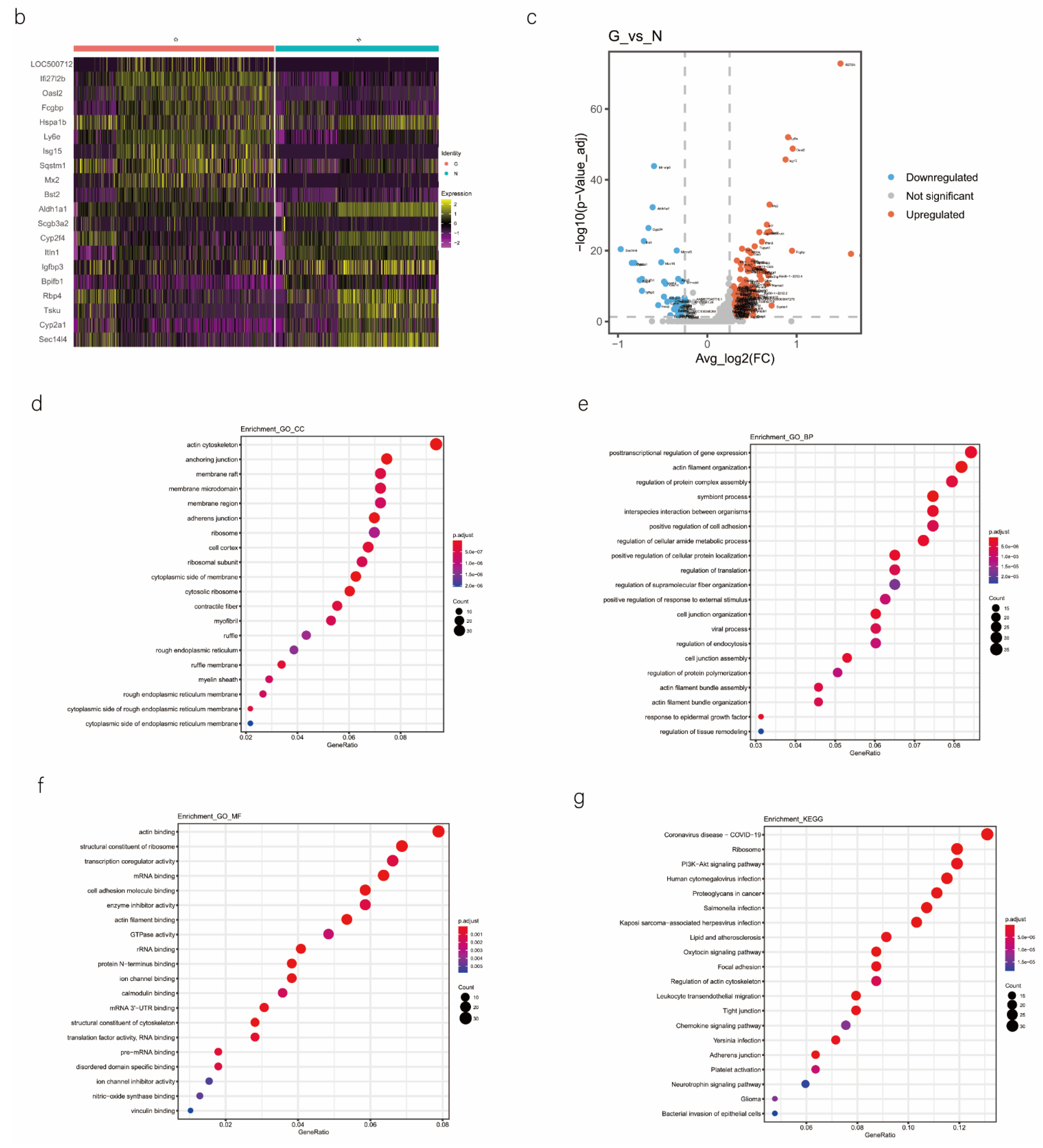

| Cluster | Gene Symbol | p_val | Avg_logFC | p_val_adj | Cell Type |
|---|---|---|---|---|---|
| AT_Sox9 | Sox9 | 2.05 × 10−177 | 1.774493058 | 4.77 × 10−173 | Alveolar epithelial progenitor |
| AT_Sox9 | Sh2d6 | 2.49 × 10−242 | 2.847097 | 5.79 × 10−238 | Alveolar epithelial progenitor |
| AT_Sox9 | Dclk1 | 4.18 × 10−209 | 1.60923 | 9.70 × 10−205 | Alveolar epithelial progenitor |
| AT_Sox9 | Rprml | 1.12 × 10−208 | 1.156296 | 2.61 × 10−204 | Alveolar epithelial progenitor |
| AT_Sox9 | Gnat3 | 5.50 × 10−185 | 1.430835 | 1.28 × 10−180 | Alveolar epithelial progenitor |
| AT_Upk3bl | Upk3bl | 0 | 1.890995855 | 0 | Alveolar epithelial |
| AT_Upk3bl | Krt15 | 2.08 × 10−258 | 1.591570036 | 4.83 × 10−254 | Alveolar epithelial |
| AT_Upk3bl | Anxa1 | 2.12 × 10−206 | 1.258136024 | 4.92 × 10−202 | Alveolar epithelial |
| AT_Upk3bl | Ppl | 8.32 × 10−201 | 1.038700757 | 1.93 × 10−196 | Alveolar epithelial |
| AT_Upk3bl | Cyp3a9 | 1.69 × 10−199 | 1.044700287 | 3.94 × 10−195 | Alveolar epithelial |
| Cillated_Cfap45 | Dynlrb2 | 0 | 2.83119973 | 0 | Ciliated epithelial |
| Cillated_Cfap45 | Aurkb | 0 | 2.474439543 | 0 | Ciliated epithelial |
| Cillated_Cfap45 | Cfap126 | 0 | 2.413891363 | 0 | Ciliated epithelial |
| Cillated_Cfap45 | Ccdc153 | 0 | 2.311122919 | 0 | Ciliated epithelial |
| Cillated_Cfap45 | RGD1565611 | 0 | 2.139924169 | 0 | Ciliated epithelial |
| Club_Scgb3a2 | Scgb1a1 | 0 | 1.590536 | 0 | Club |
| Club_Scgb3a2 | Bpifb1 | 1.07 × 10−229 | 1.377248 | 2.48 × 10−225 | Club |
| Club_Scgb3a2 | Clca1 | 3.03 × 10−219 | 0.915872 | 7.04 × 10−215 | Club |
| Club_Scgb3a2 | Gp2 | 7.42 × 10−204 | 1.547265 | 1.72 × 10−199 | Club |
| Club_Scgb3a2 | Sftpd | 1.92 × 10−182 | 0.78207 | 4.47 × 10−178 | Club |
| Fibroblast_Igf1 | Ptprc | 0 | 2.139825 | 0.167 | Fibroblasts |
| Fibroblast_Igf1 | Igf1 | 0 | 1.803506 | 0.092 | Fibroblasts |
| Fibroblast_Igf1 | Cd53 | 0 | 1.746076 | 0.121 | Fibroblasts |
| Fibroblast_Igf1 | Apbb1ip | 0 | 1.633087 | 0.085 | Fibroblasts |
| Fibroblast_Igf1 | Igsf6 | 0 | 1.62369 | 0.111 | Fibroblasts |
Disclaimer/Publisher’s Note: The statements, opinions and data contained in all publications are solely those of the individual author(s) and contributor(s) and not of MDPI and/or the editor(s). MDPI and/or the editor(s) disclaim responsibility for any injury to people or property resulting from any ideas, methods, instructions or products referred to in the content. |
© 2022 by the authors. Licensee MDPI, Basel, Switzerland. This article is an open access article distributed under the terms and conditions of the Creative Commons Attribution (CC BY) license (https://creativecommons.org/licenses/by/4.0/).
Share and Cite
Cao, C.; Memete, O.; Shao, Y.; Zhang, L.; Liu, F.; Dun, Y.; He, D.; Zhou, J.; Shen, J. Single-Cell RNA-Sequencing Reveals Epithelial Cell Signature of Multiple Subtypes in Chemically Induced Acute Lung Injury. Int. J. Mol. Sci. 2023, 24, 277. https://doi.org/10.3390/ijms24010277
Cao C, Memete O, Shao Y, Zhang L, Liu F, Dun Y, He D, Zhou J, Shen J. Single-Cell RNA-Sequencing Reveals Epithelial Cell Signature of Multiple Subtypes in Chemically Induced Acute Lung Injury. International Journal of Molecular Sciences. 2023; 24(1):277. https://doi.org/10.3390/ijms24010277
Chicago/Turabian StyleCao, Chao, Obulkasim Memete, Yiru Shao, Lin Zhang, Fuli Liu, Yu Dun, Daikun He, Jian Zhou, and Jie Shen. 2023. "Single-Cell RNA-Sequencing Reveals Epithelial Cell Signature of Multiple Subtypes in Chemically Induced Acute Lung Injury" International Journal of Molecular Sciences 24, no. 1: 277. https://doi.org/10.3390/ijms24010277
APA StyleCao, C., Memete, O., Shao, Y., Zhang, L., Liu, F., Dun, Y., He, D., Zhou, J., & Shen, J. (2023). Single-Cell RNA-Sequencing Reveals Epithelial Cell Signature of Multiple Subtypes in Chemically Induced Acute Lung Injury. International Journal of Molecular Sciences, 24(1), 277. https://doi.org/10.3390/ijms24010277







